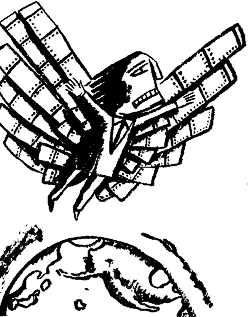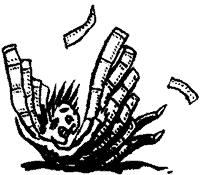
|
How Copper Came a Cropper
Sumitomo's robber-baron tactics make the case for
regulation.
By Paul Krugman
(1,171 words;
posted Friday, July 19; to be composted Friday, July 26)
Last year, the world
was astonished to hear that a young employee of the ancient British firm
Barings had lost more than a billion dollars in speculative trading, quite
literally breaking the bank. But when an even bigger financial disaster
was revealed last month--the loss of at least $1.8 billion (the true number
is rumored to be $4 billion or more) in the copper market by an employee
of Sumitomo Corp.--the story quickly faded from the front pages. "Oh
well, just another rogue trader," was the general reaction.
Thanks largely
to investigative reporting by the Financial Times, however, it has
become clear that Yasuo Hamanaka, unlike Nick Leeson of Barings, was not
a poorly supervised employee using his company's money to gamble on unpredictable
markets. On the contrary, there is little question that he was, in fact,
implementing a deliberate corporate strategy of "cornering" the
world copper market--a strategy that worked, yielding huge profits, for
a number of years. Hubris brought him down in the end; but it is his initial
success, not his eventual failure, that is the really disturbing part of
the tale.
To understand what Sumitomo was up
to, you don't need to know many details about the copper market. The essential
facts about copper (and many other commodities) are 1) It is subject to
wide fluctuations in the balance between supply and demand, and 2) It can
be stored, so that production need not be consumed at once. These two facts
mean that a certain amount of speculation is a normal and necessary part
of the way the market works: It is inevitable and desirable that people
should try to buy low and sell high, building up inventories when the price
is perceived to be unusually low and running those inventories down when
the price seems to be especially high.

|
|
|
|
 o
far so good. But a long time ago somebody--I wouldn't be surprised if it
were a Phoenician tin merchant in the first millennium B.C.--realized that
a clever man with sufficiently deep pockets could basically hold such a
market up for ransom. The details are often mind-numbingly complex, but
the principle is simple. Buy up a large part of the supply of whatever
commodity you are trying to corner--it doesn't really matter whether you
actually take claim to the stuff itself or buy up "futures,"
which are nothing but promises to deliver the stuff on a specified date--then
deliberately keep some--not all--of what you have bought off the market,
to sell later. What you have now done, if you have pulled it off, is created
an artificial shortage that sends prices soaring, allowing you to make
big profits on the stuff you do sell. You may be obliged to take some loss
on the supplies you have withheld from the market, selling them later at
lower prices, but if you do it right, this loss will be far smaller than
your gain from higher current prices. o
far so good. But a long time ago somebody--I wouldn't be surprised if it
were a Phoenician tin merchant in the first millennium B.C.--realized that
a clever man with sufficiently deep pockets could basically hold such a
market up for ransom. The details are often mind-numbingly complex, but
the principle is simple. Buy up a large part of the supply of whatever
commodity you are trying to corner--it doesn't really matter whether you
actually take claim to the stuff itself or buy up "futures,"
which are nothing but promises to deliver the stuff on a specified date--then
deliberately keep some--not all--of what you have bought off the market,
to sell later. What you have now done, if you have pulled it off, is created
an artificial shortage that sends prices soaring, allowing you to make
big profits on the stuff you do sell. You may be obliged to take some loss
on the supplies you have withheld from the market, selling them later at
lower prices, but if you do it right, this loss will be far smaller than
your gain from higher current prices.
It's nice work if you can get it;
there are only three important hitches. First, you must be able to operate
on a sufficiently large scale. Second, the strategy only works if not too
many people realize what is going on--otherwise nobody will sell to you
in the first place unless you offer a price so high that the game no longer
pays. Third, this kind of thing is, for obvious reasons, quite illegal.
(The first Phoenician who tried it probably got very rich; the second got
sacrificed to Moloch.)
 |
|
|

|
 he
amazing thing is that Sumitomo managed to overcome all these hitches. The
world copper market is immense; nonetheless, a single trader, apparently,
was able and willing to dominate that market. You might have thought that
the kind of secrecy required for such a massive market manipulation was
impossible in the modern information age--but Hamanaka pulled it off, partly
by working through British intermediaries, but mainly through a covert
alliance with Chinese firms (some of them state-owned). And as for the
regulators ... well, what about the regulators? he
amazing thing is that Sumitomo managed to overcome all these hitches. The
world copper market is immense; nonetheless, a single trader, apparently,
was able and willing to dominate that market. You might have thought that
the kind of secrecy required for such a massive market manipulation was
impossible in the modern information age--but Hamanaka pulled it off, partly
by working through British intermediaries, but mainly through a covert
alliance with Chinese firms (some of them state-owned). And as for the
regulators ... well, what about the regulators?
For that is the disturbing part of
the Sumitomo story. If Hamanaka had really been nothing more than an employee
run wild, one could not really fault regulators for failing to rein him
in; that would have been his employer's job. But he wasn't; he was, in
effect, engaged in a price-fixing conspiracy on his employer's behalf.
And while it may not have been obvious what Sumitomo was up to early in
the game, the role of "Mr. Copper" and his company in manipulating
prices has apparently been common knowledge for years among everyone familiar
with the copper market. Indeed, copper futures have been the object of
massive speculative selling by the likes of George Soros, precisely because
informed players believed that Hamanaka was keeping the price at artificially
high levels, and that it would eventually plunge. (Soros, however, gave
up a few months too soon, apparently intimidated by Sumitomo's seemingly
limitless resources.) So why was Hamanaka allowed to continue?
 |
|
|
|
 he
answer may in part be that the global nature of his activities made it
unclear who had responsibility. Should it have been Japan, because Sumitomo
is based there? Should it have been Britain, home of the London Metal Exchange?
Should it have been the United States, where much of the copper Sumitomo
ended up owning is warehoused? Beyond this confusion over responsibility,
however, one suspects that regulators were inhibited by the uncritically
pro-market ideology of our times. Many people nowadays take it as an article
of faith that free markets always take care of themselves--that there is
no need to police people like Hamanaka, because the market will automatically
punish their presumption. he
answer may in part be that the global nature of his activities made it
unclear who had responsibility. Should it have been Japan, because Sumitomo
is based there? Should it have been Britain, home of the London Metal Exchange?
Should it have been the United States, where much of the copper Sumitomo
ended up owning is warehoused? Beyond this confusion over responsibility,
however, one suspects that regulators were inhibited by the uncritically
pro-market ideology of our times. Many people nowadays take it as an article
of faith that free markets always take care of themselves--that there is
no need to police people like Hamanaka, because the market will automatically
punish their presumption.
And Sumitomo's strategy did indeed
eventually come to grief--but only because Hamanaka apparently could not
bring himself to face the fact that even the most successful market manipulator
must accept an occasional down along with the ups. Rather than sell some
of his copper at a loss, he chose to play double or nothing, trying to
repeat his initial success by driving prices ever higher; since a market
corner is necessarily a sometime thing, his unwillingness to let go led
to disaster. But had Hamanaka been a bit more flexible and realistic, Sumitomo
could have walked away from the copper market with modest losses offset
by enormous, ill-gotten gains.
The funny thing about the Sumitomo
affair is that if you ignore the exotic trimmings--the Japanese names,
the Chinese connection--it's a story right out of the robber-baron era,
the days of Jay Gould and Jim Fisk. There has been a worldwide rush to
deregulate financial markets, to bring back the good old days of the 19th
century when investors were free to make money however they saw fit. Maybe
the Sumitomo affair will remind us that not all the profitable things unfettered
investors can do with their money are socially productive; maybe it will
even remind us why we regulated financial markets in the first place.
 |
|
|
|
Paul
Krugman is a professor of economics at Stanford whose books include The
Age of Diminished Expectations and Peddling Prosperity.
Illustrations by Robert Neubecker

|
|
|